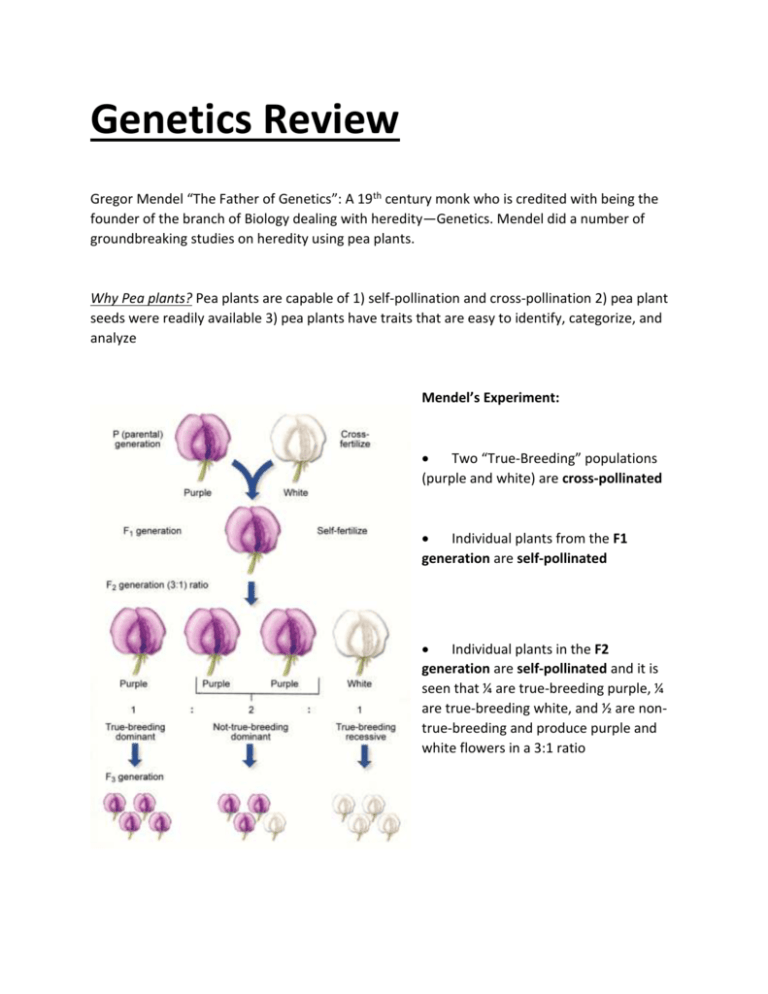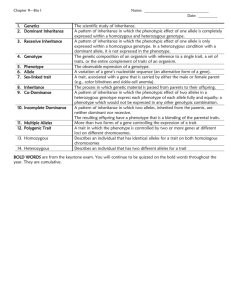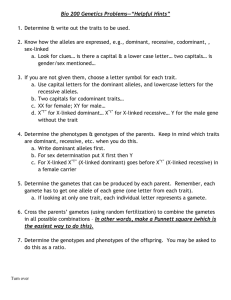genotype
advertisement

Genetics Review Gregor Mendel “The Father of Genetics”: A 19th century monk who is credited with being the founder of the branch of Biology dealing with heredity—Genetics. Mendel did a number of groundbreaking studies on heredity using pea plants. Why Pea plants? Pea plants are capable of 1) self-pollination and cross-pollination 2) pea plant seeds were readily available 3) pea plants have traits that are easy to identify, categorize, and analyze Mendel’s Experiment: Two “True-Breeding” populations (purple and white) are cross-pollinated Individual plants from the F1 generation are self-pollinated Individual plants in the F2 generation are self-pollinated and it is seen that ¼ are true-breeding purple, ¼ are true-breeding white, and ½ are nontrue-breeding and produce purple and white flowers in a 3:1 ratio From his experiments, Mendel deduced 3 laws describing patterns of inheritance from parents to offspring: 1. The Law of Dominance: If an individual has one or more copies of the dominant allele, then the dominant phenotype will be expressed (Complete Dominance). A recessive phenotype is only expressed in the absence of a dominant allele (i.e. 2 copies of the recessive allele). 2. The Law of Segregation: During gamete production, each of an individual’s 2 alleles split into separate gametes (Ex. A male who is Aa would produce half of his sperm with “A” and half of his sperm with “a”). 3. The Law of Independent Assortment: During gamete production, any combination of genetic alleles is possible (Ex. A female who is AaBb may produce eggs that are “AB” or “Ab” or “aB” or “ab”). Trait vs. Gene. vs. Allele Trait: essentially the same as “characteristic”, a trait describes how a gene is expressed EX. Eye color, hair color, blood type, etc. Gene: a segment of DNA coding for a protein that determines a single trait EX. Gene that codes for the protein Immunoglobulin (plays a part in determining blood type) Allele: a variation of a gene, can be one or more, new alleles may enter the gene pool due to mutation EX. The gene for hair color: allele for dark hair and allele for light hair; Blood type: Immunoglobulin A (type A), Immunoglobulin B (type B), no Immunoglobulin (type O) Genotype vs. Phenotype Genotype: Think “Genes”, and from “genes” think genetic code. The genotype tells us the set of alleles (gene versions) that an individual has. We use letters (alleles from mom and alleles from dad) to describe a genotype. 1. Homozygous (Homo=SAME): two of the same alleles for a gene a. Homozygous Dominant: DD b. Homozygous Recessive: dd 2. Heterozygous (Hetero=DIFFERENT): two different alleles for a gene a. Only one way to get this: Dd and dD are the same thing! Phenotype: Think “Physical”, and from “physical” think what you physically see. Multiple genotypes can produce the same phenotype. We use words (usually adjectives) to describe a phenotype. 1. Both Homozygous Dominant (DD) and Heterozygous (Dd) GENOTYPES will produce the dominant phenotype (see Law of Dominance) 2. ONLY the Homozygous Recessive (dd) GENOTYPE will produce the Recessive phenotype Inheritance Patterns 1. Complete Dominance: Follows the Law of Dominance, the presence of a dominant allele will always produce the dominant phenotype 2. Incomplete Dominance: Only homozygous dominant genotypes show the full dominant phenotype heterozygous genotypes show a blending of the recessive and dominant phenotypes 3. 4. 5. 6. 7. 8. 9. a. EX. Red Flower (RR) X White Flower (rr) produces Pink flowers (Rr) [red and white mixes to form pink] Multiple Alleles: Some genes have more than just a dominant and recessive allele, often seen in CODOMINANCE Codominance: Two or more dominant alleles are produced in the phenotype if both are present a. EX. Blood Type: IA (Type A) and IB (Type B) are dominant to i (Type O) but codominant to each other giving A, B, AB, or O as possible blood types Polygenic Traits: Traits that are influenced/determined by multiple genes a. EX. Height, skin color, eye color Pleiotropy: When one gene has effects on seemingly unrelated traits a. EX. Albinism (albino mutation): the gene affects the ability of an individual to produce pigment in the skin, hair, eyes, and other tissuesoften can result in visual difficulties in humans and increased incidence of skin cancer Autosomal Inheritance: any pattern of inheritance attributed to chromosomes 1-22 (in humans) NOT Sex-linked…Most inheritance is this type and is equally displayed in BOTH sexes Sex-Linked Inheritance: any pattern of inheritance attributed to the X or Y chromosomes because males only have one copy of the X chromosomes, any heritable traits on the X chromosome have a HIGHER INCIDENCE IN MEN THAN WOMEN Polyploidy: the presence of more than two sets of chromosomes in a cellassociated with fruiting plants a. EX. Strawberries may be 8n…meaning that they have 8 copies of each chromosome in their genome Useful Genetics Tools 1. Punnett Square: Used to visualize all possible combinations of the gametes of two parents (one parent in self-pollination). Useful for determining the probability of producing a given genotype (allele combination) or phenotype (observable description) from two individuals with known genotypes OR determining the genotypes/phenotypes of parents based on the genotypes/phenotypes of their offspring. 2. Karyotype: A picture of an individual’s chromosomes. Useful for determining the sex of an individual and any defective polyploidies a. EX. The presence of XX or XY indicates a female or male b. EX. The presence of an extra 21st chromosome indicates Down Syndrome in humans 3. Pedigree: Used to trace a trait through multiple generations of a family and determine the pattern of inheritance a. EX. A sex-linked trait will be seen mostly (if not only) in male members of the family b. EX. A recessive trait may appear in the offspring of parents who do not show the recessive phenotype TWINS: When two offspring are born in the same human birthing event (born at the same time) Fraternal Twins: Two offspring resulting from two separately fertilized eggs o Can be different sexes o Share the same relatedness as any other two siblings (NOT genetically identical) Identical Twins: Two offspring resulting from the splitting of a single fertilized egg o Genetically IDENTICAL o So…must be the same sex









